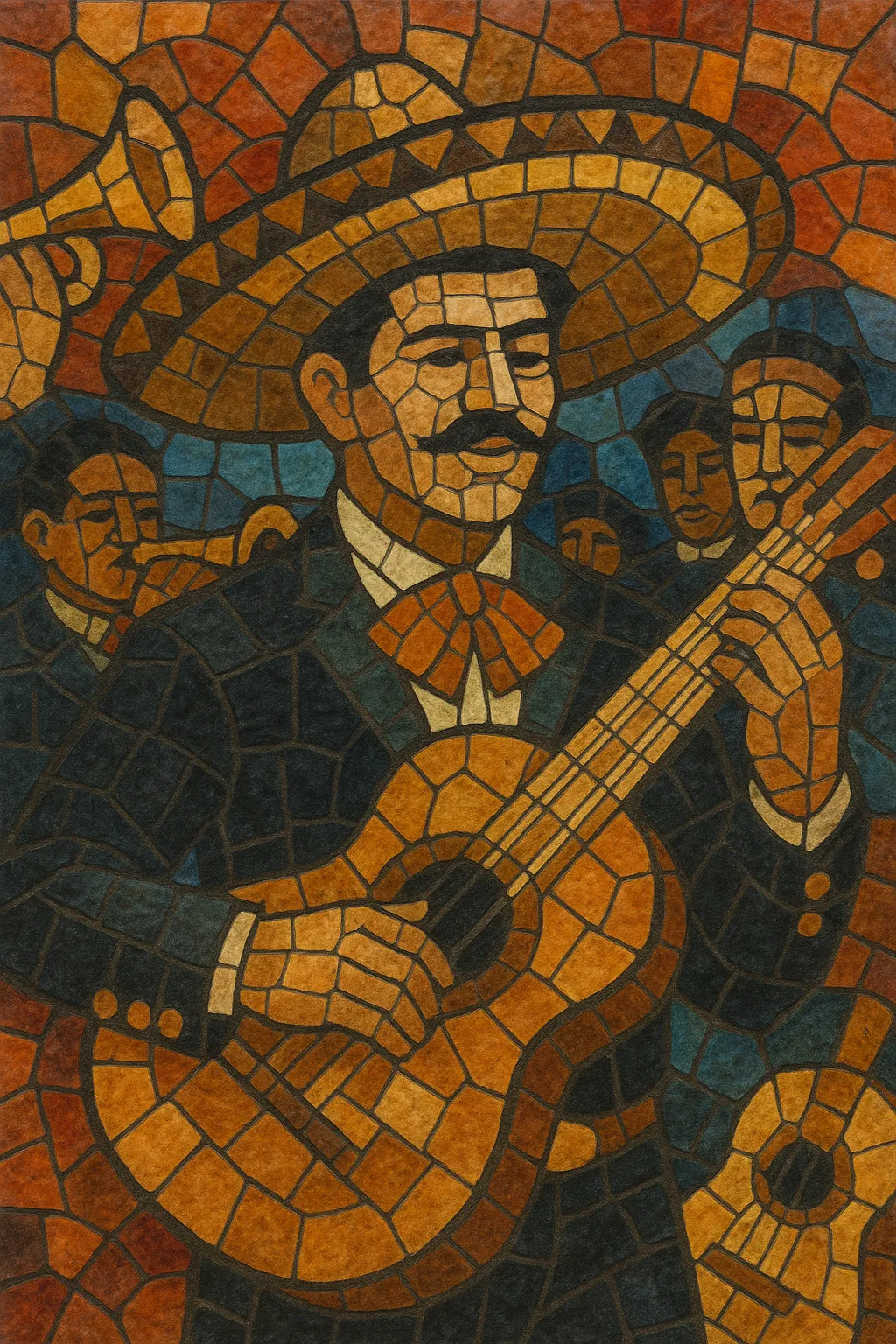Mariachi is a traditional ensemble-based music from western Mexico (especially Jalisco, Colima, Nayarit, and Michoacán) characterized by violins, trumpets, and a family of plucked guitars (vihuela, guitarrón, and guitar), with the harp used in some regional variants.
The repertoire blends rural son traditions with later urban song forms, performing sones, jarabes, huapangos, rancheras, corridos, and boleros. Rhythmic interplay between 3/4 and 6/8 (sesquiáltera), bright trumpet fanfares in parallel thirds, strummed guitar textures, and soaring group vocals with spirited gritos (shouts) are hallmarks of the style.
While rooted in 19th‑century regional string bands, modern mariachi was standardized in the 20th century through radio, cinema, and touring ensembles, becoming a national symbol of Mexico and a globally recognized sound.
Mariachi emerged in the 1800s in western Mexico as rural string ensembles performing regional son traditions (notably son jalisciense and related forms). Early groups favored violins, guitars, vihuela, guitarrón, and sometimes harp, accompanying dance and community festivities. The music’s rhythmic core featured sesquiáltera (3/4 against 6/8), and its repertoire included sones and jarabes tied to local dances and poetic forms.
After the Mexican Revolution, mariachi moved from rural plazas to urban theaters, radio, and film. The Golden Age of Mexican cinema (1930s–1950s) popularized the charro image and brought mariachi to national and international audiences. Ensembles such as Mariachi Vargas de Tecalitlán (founded in 1897) helped standardize instrumentation by adding trumpets and formalized arrangements, while singers like Jorge Negrete and Pedro Infante spread the style globally.
Professional arrangers and directors refined the ensemble’s sound—tight trumpet harmonies, violin sections in unison and in thirds/sixths, and codified strumming patterns for vihuela and guitar. The repertoire expanded to include huapango ranchero, bolero ranchero, corridos, and waltzes, as well as concert works and medleys for large stages and recordings.
Mariachi became a symbol of Mexican identity worldwide, with educational programs, youth ensembles, and festivals across the Americas, Europe, and Asia. In 2011, UNESCO recognized “Mariachi, música de cuerdas, canto y trompeta” as Intangible Cultural Heritage. Today, traditional and crossover projects coexist, from classic serenades to symphonic collaborations and pop fusions, while core aesthetics—sesquiáltera rhythms, expressive vocals, and vibrant brass‑string textures—remain intact.
Use a standard lineup of 2–6 violins, 2 trumpets, vihuela (high‑pitched 5‑string guitar), guitarrón (large fretless bass guitar), and guitar; optionally add harp for regional color. Trumpets carry fanfares and countermelodies; violins double melodies, play unisons, or harmonize in thirds/sixths; the vihuela provides bright, percussive strums; the guitarrón anchors the bass; the guitar fills harmony and rhythm.
Center rhythms on sesquiáltera: alternate or superimpose 3/4 and 6/8 feels within the same piece (e.g., huapangos and sones). For rancheras, use a steady 3/4 or 4/4 groove with characteristic rasgueado strums on vihuela/guitar. Accentuate cadences and transitions with rhythmic pushes, hemiolas, and short trumpet calls or unison violin pickups.
Favor diatonic harmony in major keys with occasional modal color and secondary dominants (I–V–I, I–IV–V, I–VI–II–V turnarounds). Common forms are strophic (verse/verse/verse) with instrumental interludes, or AABA for bolero ranchero. Insert brief introductions (entrada), modulating interludes, and a climactic cierre (ending) with rallentando and a final unison hit.
Write lyrical, singable melodies with wide intervals for expressive vocals and space for gritos. Score trumpets in parallel thirds or sixths above/below the melody; use violins for unisons, ornamental turns, and counter‑lines. Keep textures transparent: strong bass from the guitarrón, crisp rhythmic definition from the vihuela, and clear melodic hand‑offs between voice, violins, and trumpets.
Focus on love, longing, pride, place, nature, and toasts—poetic language, vivid imagery, and direct emotional expression. Employ call‑and‑response between lead voice and ensemble; place gritos tastefully to punctuate emotional peaks.
Tune trumpets and strings carefully to blend when doubling in thirds. Balance ensemble dynamics so vocals remain forward. In live settings, spot‑mic guitarrón and vihuela to preserve rhythmic clarity; use room mics for violins and a focused mic pair for trumpets to control brightness.


